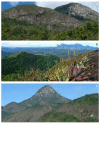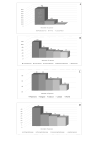Using biodiversity databases to assess vascular plant diversity in Protected Areas: a case study of Parque Estadual do Forno Grande, Brazil
- PMID: 39512813
- PMCID: PMC11541099
- DOI: 10.3897/BDJ.12.e133976
Using biodiversity databases to assess vascular plant diversity in Protected Areas: a case study of Parque Estadual do Forno Grande, Brazil
Abstract
Background: The Parque Estadual do Forno Grande is a fully protected area in the southern Espírito Santo State, Brazil. It belongs to the Atlantic Forest domain, with predominantly dense, ombrophilous, seasonal semi-deciduous forests and herbaceous/shrubby vegetation on rock outcrops. The area is recognised as highly important for conservation, designated as a priority biological area for protecting the Atlantic Forest's biodiversity. Although the importance of Protected Areas in conserving the Atlantic Forest biodiversity is unquestionable, it is crucial to understand the floristic patterns within these regions to develop effective conservation strategies. We utilised national online databases to compile species lists containing relevant information about their biodiversity. The updated list of vascular plants recorded in the Parque Estadual do Forno Grande is available in the "Catálogo de Plantas das Unidades de Conservação do Brasil" and it is presented here with further information on richness, endemism and conservation status.
New information: The Parque Estadual do Forno Grande harbours 958 species of vascular plants, of which 79.2% are angiosperms, 18.4% are ferns and 2.4% are lycophytes. Amongst these species, 44% are endemic to the Atlantic Forest. There are 58 threatened species, of which six are Critically Endangered, 39 are Endangered and 13 are Vulnerable. Amongst the threatened species, 51 are endemic to the Atlantic Forest. The number of records and the species richness in this area are notably high for Atlantic Forest standards. Our findings suggest that floristic inventories of Brazilian Protected Areas are a key contribution to the general perception of how much we still do not know about our flora. It also highlights the necessity of supporting floristic surveys in poorly-known areas, especially those remaining as forest remnants.
Keywords: Atlantic Forest; Catálogo de Plantas das Unidades de Conservação do Brasil; Protected Areas; conservation; taxonomy.
Thuane Bochorny, Guilherme M. Antar, Igor H.F. Azevedo, Fernando Bianchi Junior, Tatiana T. Carrijo, Valquiria F. Dutra, André P. Fontana, Claudio N. Fraga, Samuele Gerace, Leandro L. Giacomin, André S.B. Gil, Renato Goldenberg, Diego R. Gonzaga, Gustavo Heiden, Ingrid Koch, Ludovic J.C. Kollmann, Paulo H. Labiak, Duane F. Lima, Gabriel M. Marcusso, Pedro L.R. Moraes, Filipe Torres-Leite, Pedro L. Viana, Rafaela C. Forzza.
Figures






References
-
- Barthlott W., Porembski S. In: Inselbergs - Biotic diversity of isolated rock outcrops in tropical and temperate regions. Porembski S., Barthlott W., editors. Vol. 146. Springer; Heidelberg: 2000. Why study inselbergs? Inselbergs. Ecological Studies. - DOI
-
- Group BFG Brazilian Flora. Brazilian Flora 2020: Leveraging the power of a collaborative scientific network. Taxon. 2022;71:178–198. doi: 10.1002/tax.12640. - DOI
-
- Bochorny T., Amorim A. M.A., Antar G. M., Azevedo I. H.F., Bianchi Junior F., Carrijo T. T., Dutra V. F., Fontana A. P., Fraga C. N., Gerace S., Giacomin L. L., Gil A. S.B., Goldenberg R., Gonzaga D. R., Heiden G., Koch I., Kollmann L., Labiak P. H., Lima D. F., Marcusso G. M., Moraes P. L.R., Torres-Leite F., Viana P. L., Forzza R. Lista de espécies de plantas vasculares do Parque Estadual do Forno Grande. Janeiro Jardim Botânico do Rio de, et al., editors. https://catalogo-ucs-brasil.jbrj.gov.br Catálogo de Plantas das Unidades de Conservação do Brasil. 2022
-
- Carrijo T., Mansano V. F. Editorial. Rodriguésia. 2017;68:1504. doi: 10.1590/2175-7860201768500. - DOI
-
- Carvalho G. H., Cianciaruso M. V., Batalha M. A. Plantminer: A web tool for checking and gathering plant species taxonomic information. Environmental Modelling & Software. 2010;25:815–816. doi: 10.1016/j.envsoft.2009.11.014. - DOI
LinkOut - more resources
Full Text Sources
